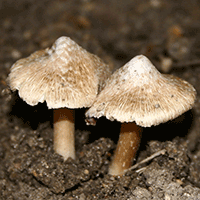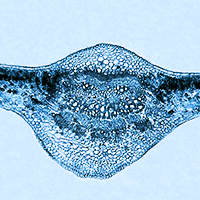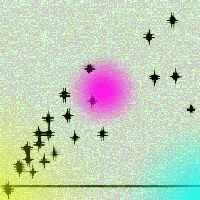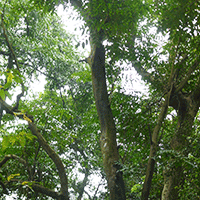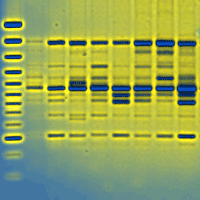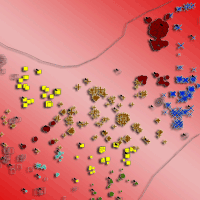We analyzed the community of ectomycorrhizal fungi of an autochthonous white poplar (Populus alba L.) stand in the Kovilj-Petrovaradin marshes (Serbia), and examined its seasonal dynamics. Ectomycorrhizal types were identified by combining morphological and anatomical descriptions with molecular methods (sequencing of ITS region of ribosomal DNA). In two seasons, 20 ectomycorrhizal types were recorded, from which 11 types were identified to the species level, six were determined to the genus level, two types were determined to the family level and one type remained unidentified. Number of ectomycorrhizal types, number of fine roots, percentage of vital mycorrhizal roots, diversity indexes and abundance of exploration types did not differ significantly between autumn and spring. During both seasons, the most abundant types were: Entoloma sp., Tuber maculatum, Cenococcum geophilum, Tuber rufum and Peziza sp. Due to the high variation of the ectomycorrhizal types-based Shannon-Weaver diversity index in poplar stands, and the fact that poplars form dual mycorrhizal association, this index is not recommended as a reliable index for bioindication in poplar.
Keywords
, , , , , ,
Citation
Katanić M, Grebenc T, Orlović S, Matavuly M, Kovačević B, Bajc M, Kraigher H (2015). Ectomycorrhizal fungal community associated with autochthonous white poplar from Serbia. iForest 9: 330-336. - doi: 10.3832/ifor1370-008
Academic Editor
Paola Mairota
Paper history
Received: Jun 04, 2014
Accepted: Jul 10, 2015
First online: Nov 12, 2015
Publication Date: Apr 26, 2016
Publication Time: 4.17 months
© SISEF - The Italian Society of Silviculture and Forest Ecology 2015
Open Access
This article is distributed under the terms of the Creative Commons Attribution-Non Commercial 4.0 International (https://creativecommons.org/licenses/by-nc/4.0/), which permits unrestricted use, distribution, and reproduction in any medium, provided you give appropriate credit to the original author(s) and the source, provide a link to the Creative Commons license, and indicate if changes were made.

Breakdown by View Type
(Waiting for server response...)
Article Usage
Total Article Views: 50078
(from publication date up to now)
Breakdown by View Type
HTML Page Views: 41573
Abstract Page Views: 3431
PDF Downloads: 3562
Citation/Reference Downloads: 60
XML Downloads: 1452
Web Metrics
Days since publication: 3687
Overall contacts: 50078
Avg. contacts per week: 95.08
Article Citations
Article citations are based on data periodically collected from the Clarivate Web of Science web site
(last update: Mar 2025)
Total number of cites (since 2016): 6
Average cites per year: 0.60
Publication Metrics
by Dimensions ©
Articles citing this article
List of the papers citing this article based on CrossRef Cited-by.
(1)
Abarenkov K, Nilsson RH, Larsson K-H, Alexander IJ, Eberhardt U, Erland S, Høiland K, Kjøller R, Larsson E, Pennanen T, Sen R, Taylor AFS, Tedersoo L, Ursing BM, Vrålstad T, Liimatainen K, Peintner U, Kõljalg U (2010)The UNITE database for molecular identification of fungi - recent updates and future perspectives. New Phytologist 186 (2): 281-285.
CrossRef |
Gscholar
(2)
Agerer R (1991)Characterization of ectomycorrhiza. In: “Methods in Microbiology”, vol. 23 (Norris JR, Read DJ, Varma AK eds). Academic Press, London, UK, pp. 25-72.
Gscholar
(3)
Agerer R (2001)Exploration types of ectomycorrhizae. A proposal to classify ECM mycelial systems according to their patterns of differentiation and putative ecological importance. Mycorrhiza 11 (2): 107-114.
CrossRef |
Gscholar
(4)
Agerer R (2008)Colour atlas of Ectomycorrhizae, 1
st-13
th delivery. Einhorn-VerlagEduard Dietenberger, Schwäbisch Gmünd, Germany.
Gscholar
(5)
Agerer R, Danielson RM, Egli S, Ingleby K, Luoma D, Treu R (2006)Descriptions of ectomycorrhizae, 1
st-10
th delivery. Einhorn-VerlagEduard Dietenberger, Schwäbisch Gmünd, Germany.
Gscholar
(6)
Agerer R, Rambold G (2014)DEEMY - An information system for characterization and determination of Ectomycorrhizae. Web site.
Online |
Gscholar
(7)
Angelini P, Granetti B (1995)La micorrizazione di alcuni cloni micropropagati di
Populus alba L. con
Tuber magnatum Pico [ The mycorrhization of some micropropagated clones of
Populus alba L. with
Tuber magnatum Pico]. Plant Biosystems 129 (5-6): 1161-1177. [in Italian]
CrossRef |
Gscholar
(8)
Atlas R, Bartha R (1981)Introduction to microbiology. Addison-Wesley Publishing Company, Reading, UK, pp. 242-244.
Gscholar
(9)
Bahram M, Põlme S, Kõljalg U, Tedersoo L (2011)A single aspen (
Populus tremula) tree individual may potentially harbor dozens of
Cenococcum geophilum ITS genotypes and hundreds of species of ectomycorrhizal fungi. FEMS Microbiological Ecology 75: 313-320.
CrossRef |
Gscholar
(10)
Bartlett MS (1936)The square root transformation in analysis of variance. Journal of the Royal Statistical Society 3: 68-78.
Online |
Gscholar
(11)
Courty PE, Frank A, Pierrat JC, Garbaye J (2008)Temporal changes in the ectomycorrhizal community in two soil horizons of a temperate oak forest. Applied and Environmental Microbiology 74 (18): 5792-5801.
CrossRef |
Gscholar
(12)
Cripps CL (2001)Mycorrhizal fungi of aspen forests: natural occurrence and potential application. In: “Sustaining Aspen in Western Landscapes: Symposium Proceedings” (Shepperd WD, Binkley D, Bartos D L, Stohlgren T J, Eskew LG eds). Report RMRS-P-18, Rocky Mountain Research Station, USDA Forest Service, Fort Collins, Colorado, USA, pp. 285-298.
Online |
Gscholar
(13)
Cripps CL (2003)Native mycorrhizal fungi with aspen on smelter-impacted sites in the northern Rocky Mountains: occurrence and potential use in reclamation. In: Proceedings of the “National Meeting of the American Society of Mining and Reclamation and the 9th Billings Land Reclamation Symposium”. Society of Mined Land Reclamation, Lexington, KY, USA, pp. 193-208
Online |
Gscholar
(14)
Dahlberg A (2001)Community ecology of ectomycorrhizal fungi: an advancing interdisciplinary field. New Phytologist 150: 555-562.
CrossRef |
Gscholar
(15)
De Roman M, De Miguel AM (2005)Post-fire, seasonal and annual dynamics of the ectomycorrhizal community in a
Quercus ilex L. forest over a 3-year period. Mycorrhiza 15: 471-482.
CrossRef |
Gscholar
(16)
DeBellis T, Kernaghan G, Bradley R, Widden P (2006)Relationships between stand composition and ectomycorrhizal community structure in boreal mixed-wood forests. Microbial Ecology 52: 114-126.
CrossRef |
Gscholar
(17)
Di Pietro M, Churin JL, Garbaye J (2007)Differential ability of ectomycorrhizas to survive drying. Mycorrhiza 17: 547-550.
CrossRef |
Gscholar
(18)
Eichhorn MP, Paris P, Herzog F, Incoll LD, Liagre F, Mantzanas K, Mayus M, Moreno G, Papanastasis VDJ, Pilbeam D, Pisanelli A, Dupraz C (2006)Silvoarable systems in Europe - past, present and future prospects. Agroforestry Systems 67 (1): 29-50.
CrossRef |
Gscholar
(19)
Gardes M, Bruns TD (1993)ITS primers with enhanced specificity for basidiomycetes - application to the identification of ectomycorrhizae and rusts. Molecular Ecology 2: 113-118.
CrossRef |
Gscholar
(20)
Gardes M, Bruns TD (1996)Community structure of ectomycorrhizal fungi in a
Pinus muricata forest: above- and below-ground views. Canadian Journal of Botany 74: 1572-1583.
CrossRef |
Gscholar
(21)
Jakucs E (2002)Ectomycorrhizae of
Populus alba L. in south Hungary. Phyton 42: 199-210.
Online |
Gscholar
(22)
Kaldorf M, Renker C, Fladung M, Buscot F (2004)Characterization and spatial distribution of ectomycorrhizas colonizing aspen clones released in an experimental field. Mycorrhiza 14: 295-306.
CrossRef |
Gscholar
(23)
Karlinski L, Rudawska M, Leski T (2013)The influence of host genotype and soil conditions on ectomycorrhizal community of poplar clones. European Journal of Soil Biology 58: 51-58.
CrossRef |
Gscholar
(24)
Karlinski L, Rudawska M, Kieliszewska-Rokicka B, Leski T (2010)Relationship between genotype and soil environment during colonization of poplar roots by mycorrhizal and endophytic fungi. Mycorrhiza 20: 315-324.
CrossRef |
Gscholar
(25)
Katanić M, Orlović S, Grebenc T, Štupar B, Galić Z, Kovačević B, Kraigher H (2010)Identification of ectomycorrhizal types in a white poplar (
Populus alba L.) plantation near Novi Sad. Les 62 (5): 155-159.
Gscholar
(26)
Katanić M, Kovačević B, Glowska N, Paoletti E, Vasić S, Matavulj M, Kraigher H (2013)Colonization of poplar roots with ectomycorrhizal, arbuscular mycorrhizal and dark septated endophytic fungi. Topola 191/192: 17-29. [in Serbian with English summary]
Gscholar
(27)
Katanić M (2014)Diversity of mycorrhizal fungi of poplars (
Populus spp). PhD thesis, Faculty of Sciences, University of Novi Sad, Novi Sad, Serbia, pp. 194. [in Serbian with English summary]
Gscholar
(28)
Katanić M, Paoletti E, Orlovi S, Grebenc T, Kraigher H (2014)Mycorrhizal status of an ozone sensitive poplar clone treated with the anti-ozonant ethylenediurea. European Journal of Forest Research 133 (4): 735-743.
CrossRef |
Gscholar
(29)
Klašnja B, Orlović S, Galić Z, Drekić M (2006)Poplar biomass of short rotation plantations as renewable energy raw material. In: “Biomass and bioenergy new research” (Columbus F ed). Nova Science Publishers, New York, USA, pp. 35-66.
Gscholar
(30)
Klopfenstein NB, Chun YW, Kim MS, Ahuja MR, Dillon MC, Carman RC, Eskew LG (1997)Micropropagation, genetic engineering, and molecular biology of
Populus. General Technical Report, Rocky Mountain Forest and Range Experiment Station, USDA Forest Service, Fort Collins, CO, USA, pp. 326.
Online |
Gscholar
(31)
Koide RT, Shumway DL, Xu B, Sharda JN (2007)On temporal partitioning of a community of ectomycorrhizal fungi. New Phytologist 174: 420-429.
CrossRef |
Gscholar
(32)
Kõljalg U, Nilsson RH, Abarenkov K, Tedersoo L, Taylor AFS, Bahram M, Bates ST, Bruns TT, Bengtsson-Palme J, Callaghan TM, Douglas B, Drenkhan T, Eberhardt U, Dueñas M, Grebenc T, Griffith GW, Hartmann M, Kirk PM, Kohout P, Larsson E, Lindahl BD, Lücking R, Martín MP, Matheny PB, Nguyen NH, Niskanen T, Oja J, Peay KG, Peintner U, Peterson M, Põldmaa K, Saag L, Saar I, Schüßler A, Senés C, Smith ME, Suija A, Taylor DE, Telleria MT, Weiß M, Larsson KH (2013)Towards a unified paradigm for sequence-based identification of fungi. Molecular Ecology 22: 5271-5277.
CrossRef |
Gscholar
(33)
Kraigher H (1996)Types of ectomycorrhizae - their taxonomy, role and application. Zbornik Gozdarstva in Lesarstva 49: 33-66. [in Slovenian with English summary]
Gscholar
(34)
Kraigher H (1999)Diversity of types of ectomycorrhizae on Norway spruce in Slovenia. Phyton 39 (3): 199-202.
Online |
Gscholar
(35)
Kraigher H, Al Sayegh-Petkovšek S, Grebenc T, Simončič P (2007)Types of ectomycorrhiza as pollution stress indicators: case studies in Slovenia. Environmental Monitoring and Assessment 128 (1): 31-45.
CrossRef |
Gscholar
(36)
Krpata D, Peintner U, Langer I, Walter JF, Schweiger P (2008)Ectomycorrhizal communities associated with
Populus tremula growing on a heavy metal contaminated site. Mycological Research 112 (9): 1069-1079.
CrossRef |
Gscholar
(37)
Lang C, Seven J, Polle A (2011)Ectomycorrhizal fungal diversity, tree diversity and root nutrient relations in a mixed Central European forest. Mycorrhiza 21: 297-308.
CrossRef |
Gscholar
(38)
LoBuglio KF (1999)Cenococcum. In: “Ectomycorrhizal fungi key genera in profile”. Springer, Berlin, Heidelberg, Germany, pp. 287-309.
CrossRef |
Gscholar
(39)
Marjanović Z, Grebenc T, Marković M, Glišić A, Milenković M (2010)Molecular diversity and ecological specificity of truffles (genus
Tuber) originating from mid-west of the Balkan Peninsula. Sydowia 62 (1): 67-87.
Online |
Gscholar
(40)
Mašek A, Grebenc T (2011)Beech (
Fagus sylvatica L.) ectomycorrhiza and fine roots in mature forests, regeneration stands and on seedlings. Les 63 (5): 192-196. [in Slovenian with English summary]
Gscholar
(41)
Molina R, Massicotte H, Trappe JM (1992)Specificity phenomena in mycorrhizal symbiosys: community-ecological consequences and practical implications. In: “Mycorrhizal functioning: an integrative plant-fungal process” (Allen MF ed). Chapman and Hall, New York, USA, pp. 357-423.
Online |
Gscholar
(42)
Nara K, Nakaya H, Hogetsu T (2003)Ectomycorrhizal sporocarp succession and production during early primary succession on Mount Fuji. New Phytologist 158: 193-206.
CrossRef |
Gscholar
(43)
Neville J, Tessier JL, Morrison I, Scarratt J, Canning B, Klironomos JN (2002)Soil depth distribution of ecto- and arbuscular mycorrhizal fungi associated with
Populus tremuloides within a 3-year-old boreal forest clear-cut. Applied Soil Ecology 19: 209-216.
CrossRef |
Gscholar
(44)
Newman LA, Strand SE, Choe N, Duffy J, Ekuan G, Ruszaj M, Shurleff BB, Wilmoth J, Heilman P, Gordon MP (1997)Uptake and biotransformation of trichloroethylene by hybrid poplars. Environment, Science and Technology 31: 1062-1067.
CrossRef |
Gscholar
(45)
O’Hanlon R, Harrington TJ (2012)Similar taxonomic richness but different communities of ectomycorrhizas in native forests and non-native plantation forests. Mycorrhiza 22: 371-382.
CrossRef |
Gscholar
(46)
Pickles BJ, Genney DR, Potts JM, Lennon JJ, Anderson IC, Alexander IJ (2010)Spatial and temporal ecology of Scots pine ectomycorrhizas. New Phytologist 186: 755-768.
CrossRef |
Gscholar
(47)
Quoreshi AM (2008)The use of mycorrhizal biotechnology in reforestation of disturbed ecosystem. In: “Mycorrhizae: Sustainable Agriculture and Forestry”. Springer, The Netherlands, pp. 303-320.
CrossRef |
Gscholar
(48)
Richard F, Roy M, Shahin O, Sthultz C, Duchemin M, Joffre R, Selosse M-A (2011)Ectomycorrhizal communities in a Mediterranean forest ecosystem dominated by
Quercus ilex: seasonal dynamics and response to drought in the surface organic horizon. Annals of Forest Science 68: 57-68.
CrossRef |
Gscholar
(49)
Rudawska M, Leski T, Stasinska M. (2011)Species and functional diversity of ectomycorrhizal fungal communities on Scots pine (
Pinus sylvestris L.) trees on three different sites. Annals of Forest Science 68: 5-15.
CrossRef |
Gscholar
(50)
Smith SE, Read DJ (2008)Mycorrhizal symbiosis (3rd edn). Elsevier-Academic Press, London, UK, pp. 787.
Gscholar
(51)
Snedecor W, Cochran WG (1976)Statistical methods (6th edn). The Iowa State University Press, Ames, Iowa, USA, pp. 503.
Gscholar
(52)
Stanojević G (2012)Analysis of annual sums of precipitation in Serbia. Journal of Geographical Institute Jovan Cvijić 62 (2): 1-13.
CrossRef |
Gscholar
(53)
Taylor AFS, Martin F, Read DJ (2000)Fungal diversity in ectomycorrhizal communities of Norway spruce (
Picea abies (L.) Karst.) and beech (
Fagus sylvatica L.) along north-south transects in Europe. In: “Carbon and nitrogen cycling in European forest ecosystems” (Schulze E-D ed). Ecological Studies 142, Springer-Verlag, Berlin-Heidelberg, Germany, pp. 343-365.
CrossRef |
Gscholar
(54)
Visser S, Maynard D, Danieson RM (1998)Response of ecto- and arbuscular fungi to clear-cutting and the application of chipped aspen wood in a mixedwood site in Alberta, Canada. Applied Soil Ecology 7: 257-269.
CrossRef |
Gscholar
